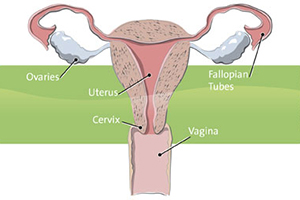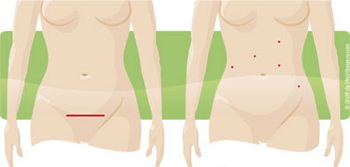Endometrial Cancer

The TriHealth Cancer & Blood Institute offers several treatments for those diagnosed with endometrial cancer, including chemotherapy, radiation therapy and hormone therapy. The cornerstone of therapy for endometrial cancer, however, is surgery.
Surgical Treatment for Endometrial Cancer
There are different surgical approaches that can be used, but the standard is a total hysterectomy/bilateral salpingo-oophorectomy. In this combined procedure, the uterus, cervix, ovaries and fallopian tubes are removed. Several scientific studies over the past 10 years have shown that also removing the lymph nodes at the time of this surgery -– lymph node dissection –- provides a survival advantage and lessens the chance that additional treatment, such as radiation therapy, will be necessary after surgery.
When cancer is involved, the conventional treatment has always been open surgery using a large abdominal incision, in order to see and, if necessary, remove related structures like the cervix or the ovaries. This approach requires a 6 to 12-inch abdominal incision, and results in a three- to four-day hospital stay and a six- to eight-week recovery time.
Robotic-Assisted Surgery: A Less Invasive Option

Robotic-assisted hysterectomy and removal of the ovaries, fallopian tubes and lymph nodes is a less invasive surgical option for the treatment of endometrial cancer.
Benefits of Robotic-Assisted Hysterectomy
When performed robotically with the da Vinci Surgical System, endometrial cancer surgery is done with unparalleled precision and control through a few small incisions along the abdomen. It offers numerous potential benefits over other surgical methods, including:
- Significantly less pain
- Less blood loss
- Fewer transfusions
- Less risk of infection
- Less scarring
- Shorter hospital stay
- Shorter recovery time
Additionally, robotic-assisted surgery allows surgeons better visualization of anatomy, which is especially critical when working around delicate and confined structures like the bladder. This means that surgeons have a distinct advantage when performing a complex, radical hysterectomy involving adhesions from prior pelvic surgery or non-localized cancer, or an abdominal hysterectomy.
As with any surgery, these benefits cannot be guaranteed, as surgery is both patient- and procedure-specific. While robotic-assisted surgery is considered safe and effective, it may not be appropriate for every individual. Always ask your doctor about all treatment options, as well as their risks and benefits.
Illustrations courtesy of Intuitive Surgical, Inc.